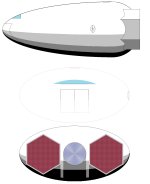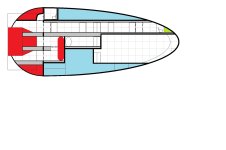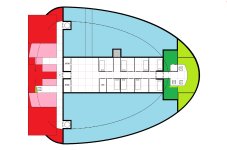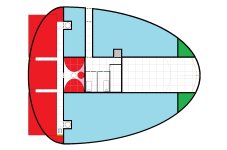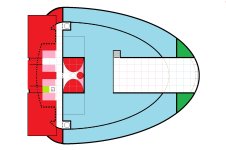Middle Deck (of three):

This deck includes the personnel airlock, passenger/gunner staterooms, low berths, and the upper 3m of the 6m tall cargo hold.
The passenger/gunner lounge doubles as the entry reception area.
If a second or third turret is installed, the gunners are quartered here. Otherwise, this is space for up to two middle passengers.
The third room here holds eight low berths. (The mid passengers might get creeped out by spending a week next to a bunch of corpsicles....)
Note that there is no direct access from the staterooms to either the drive bay or the cargo hold.
The blue line paralleling the cargo hold doors is the level at which the curve of the hull is 3m from the ceiling of the cargo hold. The parting line of the cargo hold doors is shown along the centerline, fading away into the distance (ha!) of the deck below.

This deck includes the personnel airlock, passenger/gunner staterooms, low berths, and the upper 3m of the 6m tall cargo hold.
The passenger/gunner lounge doubles as the entry reception area.
If a second or third turret is installed, the gunners are quartered here. Otherwise, this is space for up to two middle passengers.
The third room here holds eight low berths. (The mid passengers might get creeped out by spending a week next to a bunch of corpsicles....)
Spoiler:
Yeah, the room doesn't have enough space -- but this section of the deck does have the volume for two staterooms and 4Td for the low berths. I'm invoking artistic license.
Note that there is no direct access from the staterooms to either the drive bay or the cargo hold.
The blue line paralleling the cargo hold doors is the level at which the curve of the hull is 3m from the ceiling of the cargo hold. The parting line of the cargo hold doors is shown along the centerline, fading away into the distance (ha!) of the deck below.
Last edited:


